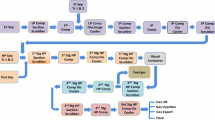Abstract
Specimens of copper tubing from an industrial scale chiller were subjected to a complete corrosion failure analysis. Nondestructive inspection of the tubing indicated substantial corrosion damage and provided the impetus for the corrosion analysis. By application of the typical methods encountered in metallurgical failure investigations, as well as additional chemical analysis techniques, the most probable cause of failure was identified to be a change in the water chemistry during the service life of the tubes. Additional items that may have contributed to the failure include the geometric design of the tube and the post-manufacture cleaning process prior to service. Recommendations were made regarding water treatment and the requirements for any replacement tubes. In addition to discussion of the specific failure(s) investigated, notes regarding the general procedures for corrosion failure analysis are also presented.
Similar content being viewed by others
References
P.J.L. Fernandes: “Type I Pitting of Copper Tubes from a Water Distribution System,”Eng. Fail. Anal., 5, 1997, pp. 35–40.
N.W. Polan et al.: “Corrosion of Copper and Copper Alloys,”Corrosion, Vol 13,ASM Handbook, ASM International, 1987, pp. 611–640.
H. Otmacic and E. Stupnisek-Lisac: “Copper Corrosion Inhibitors in Near Neutral Media,”Electrochim. Acta, 48, 2003, pp. 985–991
E. Protopopoff and P. Marcus: “Potential-pH Diagrams for Sulphur and Hydroxyl Adsorbed on Copper Surfaces in Water Containing Sulfides, Sulfites or Thiosulfates,”Corros. Sci., 45, 2003, pp. 1191–1201.
B. Rosales, R. Vera, and G. Moriena: “Evaluation of the Protective Properties of Natural and Artifical Patinas on Copper: Part I,”Corros. Sci., 41, 1999, pp. 625–651.
H.M. Herro and R.D. Port:The NALCO Guide to Cooling Water Systems Failure Analysis, McGraw-Hill, New York, NY, 1993.
M. Chmielova, J. Seidlerova, and Z. Weiss: “X-ray Diffraction Phase Analysis of Crystalline Copper Corrosion Products in Different Chloride Solutions,”Corros. Sci., 45, 2003, pp. 883–889.
R.J. Oliphant: “Causes of Copper Corrosion in Plumbing Systems—A Review of Current Knowledge,” Foundation of Water Research, 2003.
W.F. Langelier: “The Analytical Control of Anti-Corrosion Water Treatment,”J. American Water Works Association, 28, 1936, pp. 1500–1521.
G. Mankowski, J.P. Duthil, and A. Giusti: “The Pit Morphology on Copper in Chloride and Sulphate Containing Solutions,”Corros. Sci., 39, 1, 1997, pp. 27–42.
A. Broo, B. Berghult, and T.G. Hedberg: “Copper Corrosion in Drinking Water Distribution Systems—the Influence of Water Quality,”Corros. Sci. 39, 6, 1997, pp. 1119–1132.
L.M. McGaughey and J.V. Matson: “Prediction of the Calcium Carbonate Saturation pH in Cooling Water,”Water Research, 14, 1980, pp. 1729–1735.
E. Geler and D.S. Azambuja: “Corrosion Inhibition of Copper in Chloride Solutions by Pyrazole,”Corros. Sci., 42, 2000, pp. 631–643.
F. Zucchi, G. Trabanelli, and C. Monticelli: “The Inhibition of Copper Corrosion in 0.1 M NaCl under Heat Exchange Conditions,”Corros. Sci., 38, 1995, pp. 147–154.
C.R. Brooks and A. Choudhury:Metallurgical Failure Analysis, McGraw-Hill, New York, NY, 1993.
V.J. Colangelo and F.A. Heiser:Analysis of Metallurgical Failures, 2nd ed., Wiley Interscience, New York, NY, 1974.
D.P. Dennies: “The Organization of a Failure Investigation,”Pr. Fail. Anal., 2(3), ASM International, 2002, pp. 11–16, 33–41.
S.P. Lynch: “Failures of Structures and Components by Environmentally Assisted Cracking,”Eng. Fail. Anal., 1, 1994, pp. 77–90.
A.J. McEvily:Metal Failures: Mechanisms, Analysis, Prevention, Wiley-Interscience, New York, NY, 2001.
G.W. Vander Voort: “Conducting the Failure Examination,”Pr. Fail. Anal., 2001,1(2), pp. 14–19, 38–46.
D.J. Wulpi:Understanding How Components Fail, 2nd ed., ASM International, 1999.
“Practices in Failure Analysis,”Failure Analysis and Prevention, vol. 11,ASM Handbook, R.J. Shipley and W.T. Becker, ed., ASM International, 2002, pp. 393–417.
“Techniques for Diagnosis of Corrosion Failures,”Corrosion: Understanding the Basics, J.R. Davis, ed., ASM International, 2000, pp. 475–496.
M.E. Schrader: “Auger Electron Spectroscopic Study of Mechanism of Sulfide Accelerated Corrosion of Copper Nickel Alloy in Seawater,”Applic. Surf. Sci., 10, 1982, pp. 431–445.
S. Colin, E. Beche, R. Berjoan, H. Jolibois, and A. Chambaudet: “An XPS and AES Study of the Free Corrosion of Cu, Ni, and Zn Based Alloys in Synthetic Sweat,”Corros. Sci., 41, 1999, pp. 1051–1065.
Author information
Authors and Affiliations
Rights and permissions
About this article
Cite this article
McDougall, J.L., McCall, L. & Stevenson, M.E. Water chemistry and processing effects on the corrosion degradation of copper tubing in cooling water systems. Practical Failure Analysis 3, 81–88 (2003). https://doi.org/10.1007/BF02717490
Received:
Revised:
Issue Date:
DOI: https://doi.org/10.1007/BF02717490




